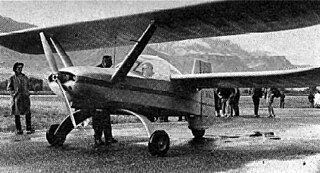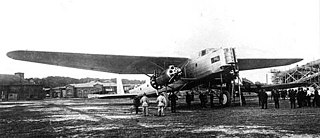Related Research Articles

The Flying Flea is a large family of light homebuilt aircraft first flown in 1933.

The Croses EC-6 Criquet ("Locust") is a 1960s French two-seat homebuilt aircraft designed by Emilien Croses.
The Croses EC-9 Para-Cargo is a 1960s French six-seat tandem-wing cargo-carrying homebuilt aircraft designed by Emilien Croses.
The Civil Aviation Department Revathi was a light utility aircraft designed in India principally for use by that country's flying clubs.

The Cvjetkovic CA-65 Skyfly is a 1960s American homebuilt monoplane aircraft designed by Anton Cvjetkovic.

The Croses Pouplume ("lousefeather") was an unusual ultralight aircraft developed in France in the 1960s. It was inspired by Henri Mignet's Pou-du-Ciel design with its distinctive tandem wing layout. Croses set out to develop a similar aircraft, to be powered by a single-cylinder motorcycle engine of around 6 kW (8 hp). Construction was wood with fabric covering. The resulting machine, designated the EC-1 weighed only 108 kg (238 lb) empty, and first flew in about 1960. Like the Pou-du-Ciel, the Pouplume dispensed with traditional ailerons and elevators, and pivoted the entire forward wing to provide pitch control.

The Piel CP-30 Emeraude is an aircraft designed in France in the mid-1950s and widely built both by factories and homebuilders.
The Keleher JK-1 Lark is a single-seat aerobatic sport aircraft that was designed in the United States in the early 1960s and later marketed for homebuilding. It is a conventional, mid-wing, strut-braced monoplane with fixed tailwheel undercarriage. The fuselage and empennage are of welded steel tube construction, skinned in fabric. The wings are wooden and also covered in fabric. The design was revised in 1963, with the new version designated Lark 1B. Plans for this version were offered for sale from 1968 and were still on sale into the 1980s. An example of the 1B won the "Outstanding Workmanship" award for L. C. Koetkemeyer at the 1968 EAA Fly-in.

The Lederlin 380L is an unconventional light aircraft developed in France in the 1960s, and marketed for homebuilding.

The Grigorovich TB-5 was an experimental heavy bomber designed and tested in the Soviet Union in the early 1930s. Designed as a competitor for the Tupolev TB-3, the TB-5 was intended to be powered by two FED 24-cylinder X engines of 746 kW (1,000 hp) each. When these were canceled, the underwing pods were revised to each house a pair of Bristol Jupiter engines in a push-pull configuration. Despite projected performance inferior to TB-3, it was hoped that TB-5 would gain an advantage by using less metal thanks to its mixed construction of fabric-covered metal frame.

The Piel CP.70 Beryl is a French twin-seat, single-engine sport aircraft designed by Claude Piel. It was first flown in France in the 1960s and marketed for amateur construction.

The Piel CP.80 Zephir , Piel CP.801 and Piel CP.802 are racing aircraft developed in France in the 1970s and marketed for homebuilding. They are compact, single-seat, single-engine monoplanes with low, cantilever wings.
The Piel CP.90 Pinocchio II was a single-seat, single-engine aerobatic sport aircraft developed in France and marketed for homebuilding. The design was based on that of Piel's Emeraude and was unrelated to Piel's first design named Pinocchio, the CP.10 and indirectly to the second, the CP.20. It was a cantilever, low-wing monoplane of conventional design with an enclosed cockpit and fixed, tailwheel undercarriage. Construction was of wood throughout.

The Piel CP.60 Diamant is a single-engine light aircraft designed in France in the 1960s and marketed for home building.
The Piel CP-150 Onyx is a single-seat, low-cost and low-power ultralight aircraft. The aircraft was designed by French aeronautical engineer Claude Piel. The aircraft is an all-wood single seat microlight based on Mignet principles with fixed tricycle undercarriage and one 12 hp Solo engine.

The Gotha Go 147 was a German experimental two-seat tailless aircraft designed in 1936 by Gothaer Waggonfabrik and Dr. A. Kupper. Two examples were built and flown. Development was abandoned before the start of World War II.
The SITAR GY-90 Mowgli was a light aircraft designed in France in the late 1960s and marketed for homebuilding. Designer Yves Gardan intended it to be a smaller and simpler version of his Bagheera, a conventional low-wing, cantilever monoplane with fixed tricycle undercarriage and a fully enclosed cabin. However, although the Bagheera had seating for up to four people in 2+2 configuration, the Mowgli had no rear seat and could seat only two people, with space behind the seats for luggage. Like the Bagheera, construction was of metal throughout. The Mowgli was designed to use either a 67-kW (90-hp) or 75-kW (100-hp) Continental flat-4 engine.
The Briffaud GB-10 Pou-Push was a Mignet style tandem wing single seat aircraft with a pusher configuration single engine. The sole example was built in France in the 1980s.
The Piel CP-10 was a post-war French sports aircraft in the Pou du Ciel tradition and was the first design from Claude Piel to fly.
The Piel CP-20 Pinocchio is a single engine French sport monoplane first flown in 1951. Only two were built but one was still flying over sixty years later.
References
- Gunston, Bill (1993). World Encyclopedia of Aircraft Manufacturers. Annapolis: Naval Institute Press.
- Jane's All the World's Aircraft 1977–78. London: Jane's Publishing.
- Roskam, Jan (1997). Airplane Design Part II: Preliminary Configuration Design and Integration of the Propulsion System. Lawrence, Kansas: DARcorporation.
- Taylor, Michael J. H. (1989). Jane's Encyclopedia of Aviation. London: Studio Editions.